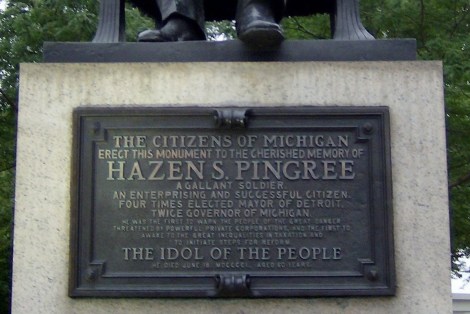I’d been passing by the statue here in Detroit for days now without noticing it, but today something — the gloomy weather, maybe — made me slow down and read the inscription.
The citizens of Michigan erect this monument to the cherished memory of Hazen S. Pingree. A gallant soldier, an enterprising and successful citizen, four times elected mayor of Detroit, twice governor of Michigan. He was the first to warn the people of the great danger threatened by powerful private corporations. And the first to awake to the great inequalities in taxation and to initiate steps for reform. The idol of the people.
The idol of the people, huh? I had never heard of this guy. Growing up in metro Detroit, I had learned two things about Detroit’s history: 1. Detroit used to be French, and 2. Henry Ford was a genius.
Hazen Pingree became mayor of Detroit in 1890, three years before the worst depression that America had ever experienced (until the 1930s, anyway). The railroads, which had used speculative financing to expand all over the country, began to collapse. So did banks — hundreds of them.
No one knew quite what to do. America had just sprawled itself out along the path of the railroad, without imagining that this amazing technology boom might not last forever. Farmers began to go under because they couldn’t get their goods to market, and people in cities began to go hungry because they couldn’t afford the food that was still being shipped in from the countryside. Nearly half of Michigan’s population was unemployed.

Pingree seems to have practiced the kind of sensible governance that doesn’t usually make the history books. In his book American Odyssey, the historian Robert Conot describes the horrible state of Detroit’s streets when Pingree became mayor: A consortium of lumber dealers had persuaded the previous administration to tear up its perfectly good cobblestone streets and replace them with cedar blocks. The wooden paving turned out to float away in heavy rainstorms, and — even better — catch on fire in the summer.
Pingree repaved the entire city, built the city’s first municipal power plant, added 68 miles of municipal rail lines, and developed a large-scale public works program. He paid for it all by bringing in an assessor to see if property taxes were being calculated fairly all over the city. They weren’t — as it turned out, speculators were being assessed at about half the rate that homeowners were, and companies that were headquartered in Detroit were evading taxes by listing their main business address as a shack built just outside the city limits.
But it was Pingree’s wife, Frances, who came up with the idea that Pingree is most often remembered for. She noticed that the still-growing city was patchworked with vacant lots. If people were hungry and unemployed all over the city, why couldn’t the lots be turned into temporary vegetable gardens until the recession was over?
The measure was popular with would-be gardeners, though less popular with the people who actually owned the vacant lots. Hazen Pingree managed to secure the loan of 500 acres across the city — only a third of the amount needed to supply the 3,000 families that had applied for half-acre garden plots, but still better than nothing. After a call for donations to help pay for seed and equipment yielded minuscule donations, Pingree auctioned off his prize saddle horse as a combination PR stunt/fundraiser/shaming gesture. By the time the autumn harvest yielded a bumper crop, the mayor had a new nickname: “Potato Patch Pingree.”
Pingree served for three terms before becoming governor of Michigan. That didn’t work out as well — Pingree faced well-organized opposition at the state level that blocked nearly all of his legislation. He died shortly after retiring, from an infection that he picked up while on an ill-advised big game hunting expedition.
At the news of his death, the emotional state of Detroit could best be described as verklempt. “He was the type of man behind whom half of medieval Europe might have marched,” wrote the Detroit News, in his obituary on June 19, 1901. “In another state of society, he might have founded a religion or an empire.” Thousands of Detroiters donated dollars and quarters so that a statue in his memory could be installed downtown. The statue of Pingree has sat there, in more or less that same spot, for the 100 years since then, looking down on protestors and dog-walkers and baseball fans and drunken bar patrons and lunching office workers ever since then.
Today Detroit is facing a lot of the same troubles it encountered in Pingree’s day — and its residents are showing a lot of the same resourcefulness. I can’t help wondering: If those of us growing up in Detroit had been told more stories about the city’s past than just “Henry Ford saved us,” maybe we would have been better at navigating the hard times when they did come, the way that they always do.


